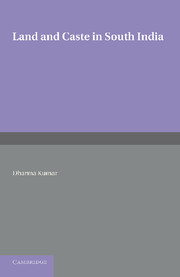 Land and Caste in South India
Land and Caste in South India Book contents
- Frontmatter
- Dedication
- CONTENTS
- List of Tables and Figures
- Acknowledgements and A Note on Certain Connventions
- Abbreviations
- Map of the Madras Presidency
- PART I
- PART II
- VII LAND AND POPULATION
- VIII EMIGRATION
- IX WAGES
- X THE GROWTH OF AGRICULTURAL LABOUR FROM 1871 TO 1901
- XI CONCLUSION
- Glossary
- Bibliography
- Index
X - THE GROWTH OF AGRICULTURAL LABOUR FROM 1871 TO 1901
from PART II
Published online by Cambridge University Press: 05 June 2016
- Frontmatter
- Dedication
- CONTENTS
- List of Tables and Figures
- Acknowledgements and A Note on Certain Connventions
- Abbreviations
- Map of the Madras Presidency
- PART I
- PART II
- VII LAND AND POPULATION
- VIII EMIGRATION
- IX WAGES
- X THE GROWTH OF AGRICULTURAL LABOUR FROM 1871 TO 1901
- XI CONCLUSION
- Glossary
- Bibliography
- Index
Summary
It was argued in Chapter IV that at the beginning of the nineteenth century the great majority of traditional agricultural labour castes in most of the Tamil districts, Malabar and South Canara were in fact agricultural labourers, owning little or no land, and deriving the major part of their income from agricultural labour. If this hypothesis is correct then at least 10-15 per cent of the total population in these districts would have been agricultural labourers; and there are no indications that the proportion of agricultural labourers in the other districts was widely different. The data on which this argument is based relate to the first forty years or so of the century, after which there is no information on the strength of agricultural labour till 1871. Details of occupation are given in the decennial censuses from 1871 onwards so that it is possible to make a rough estimate of the growth of this class over the century; and for the last thirty years of the century one can relate movements in agricultural labour to changes in the strength of landowners and tenants.
The Censuses are, of course, very much more satisfactory than the sources available for the earlier period, but even so they are not perfectly comparable with each other. Apart from the difficulties of definition and classification inherent in the facts, there are several problems raised by the changes in the system of classification made in each Census. (These changes are set out in Appendix I to this chapter. The only changes relevant here are, first, that while from 1881 onwards separate figures are given for the two ‘orders’, agriculture and pasture, in 1871 the two orders are combined. Naturally each Census improves on its predecessors as regards detail. In 1871 the group ‘agriculture’ merely covers ‘cultivators’ agricultural labourers are excluded, and no breakdown between landlords and tenants is available. From 1881 onwards it is possible to subdivide ‘agriculture’ into the three broad groups of landholders, tenants and labourers, and in 1891 and 1901 these can be further subdivided into cultivating/non-cultivating landholders/tenants, and ‘farm servants’ and ‘field labourers’.
Apart from these classificatory changes, there were changes in the universe classified in each Census.
- Type
- Chapter
- Information
- Land and Caste in South IndiaAgricultural Labour in the Madras Presidency during the Nineteenth Century, pp. 168 - 185Publisher: Cambridge University PressPrint publication year: 2013


